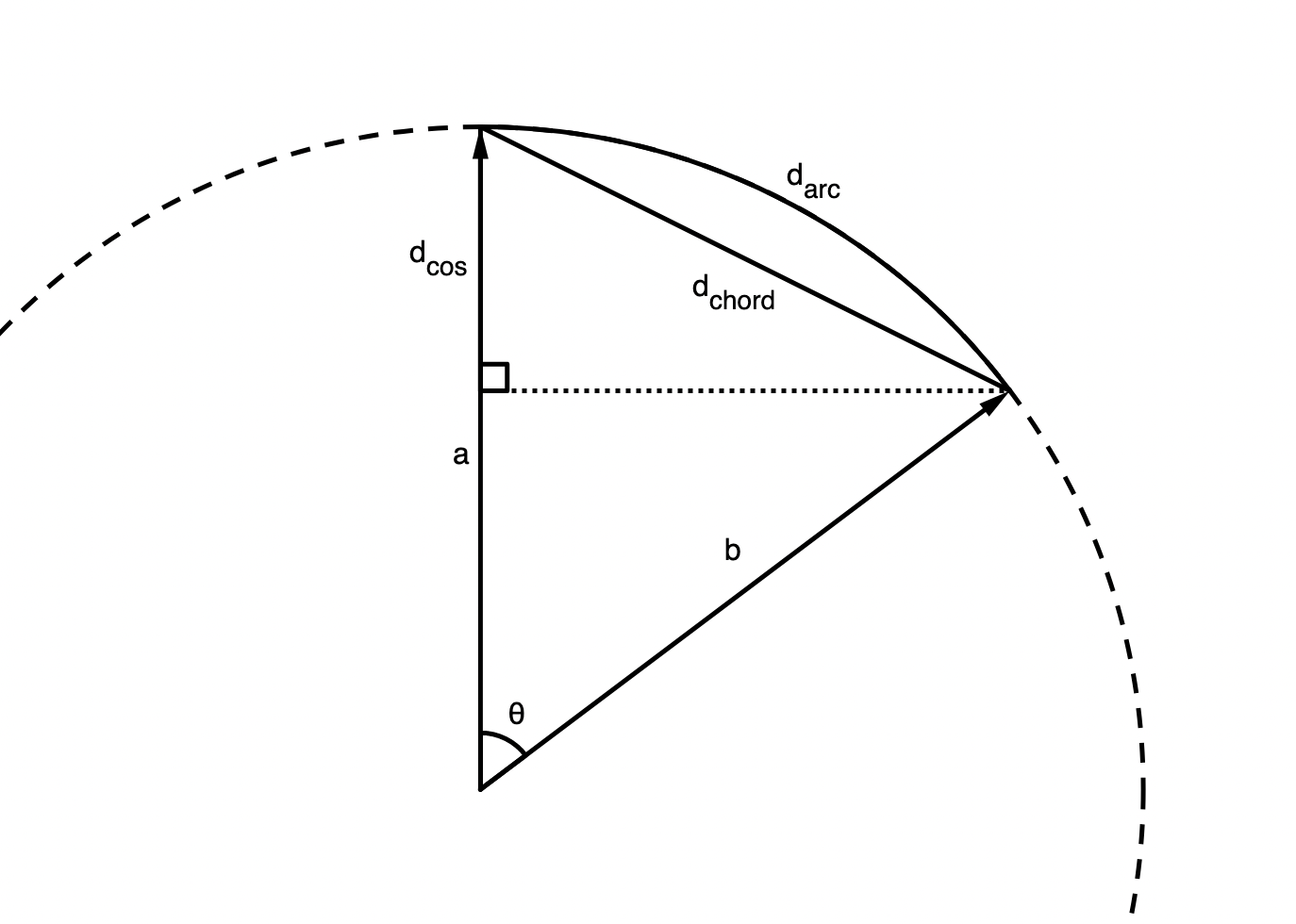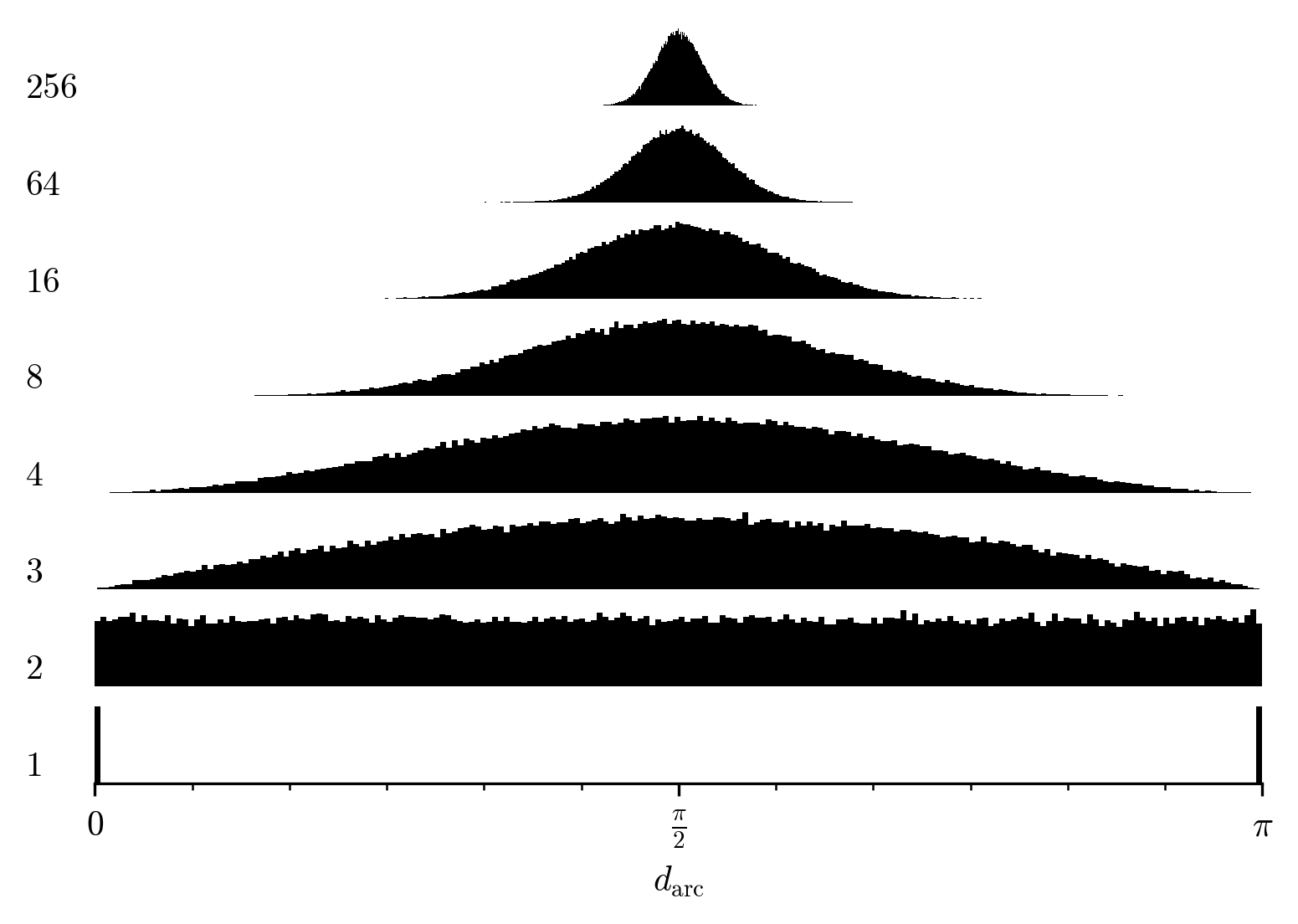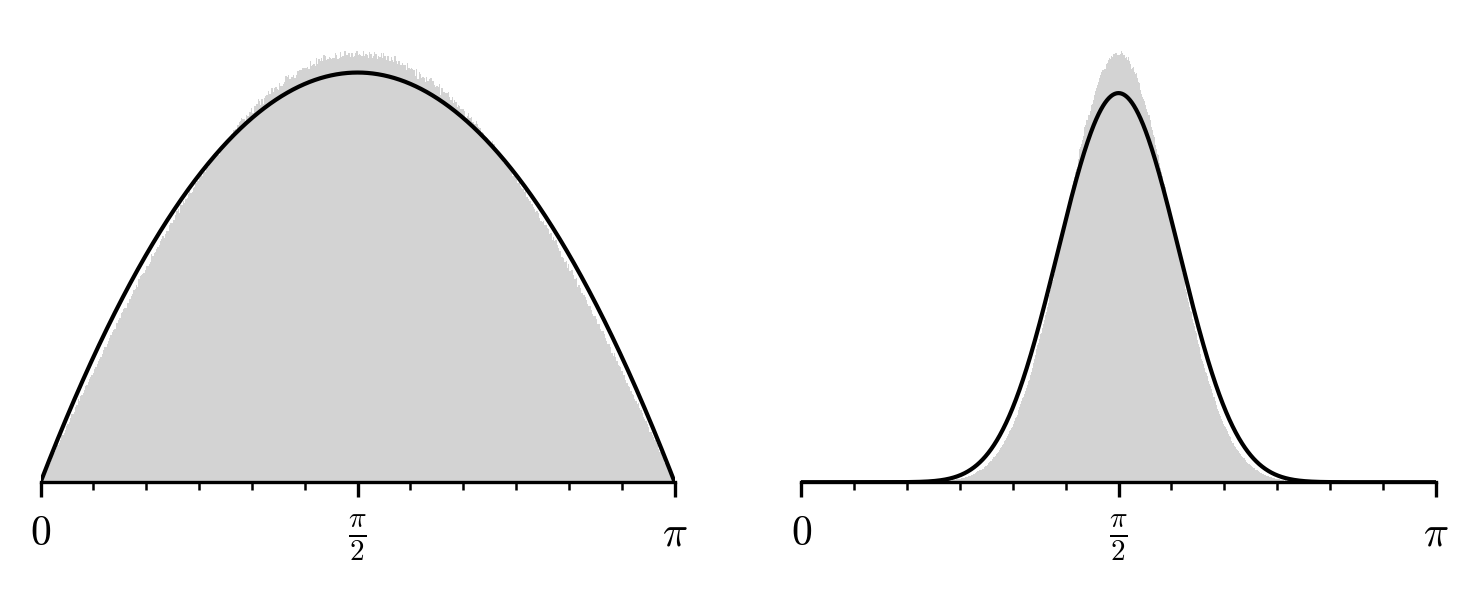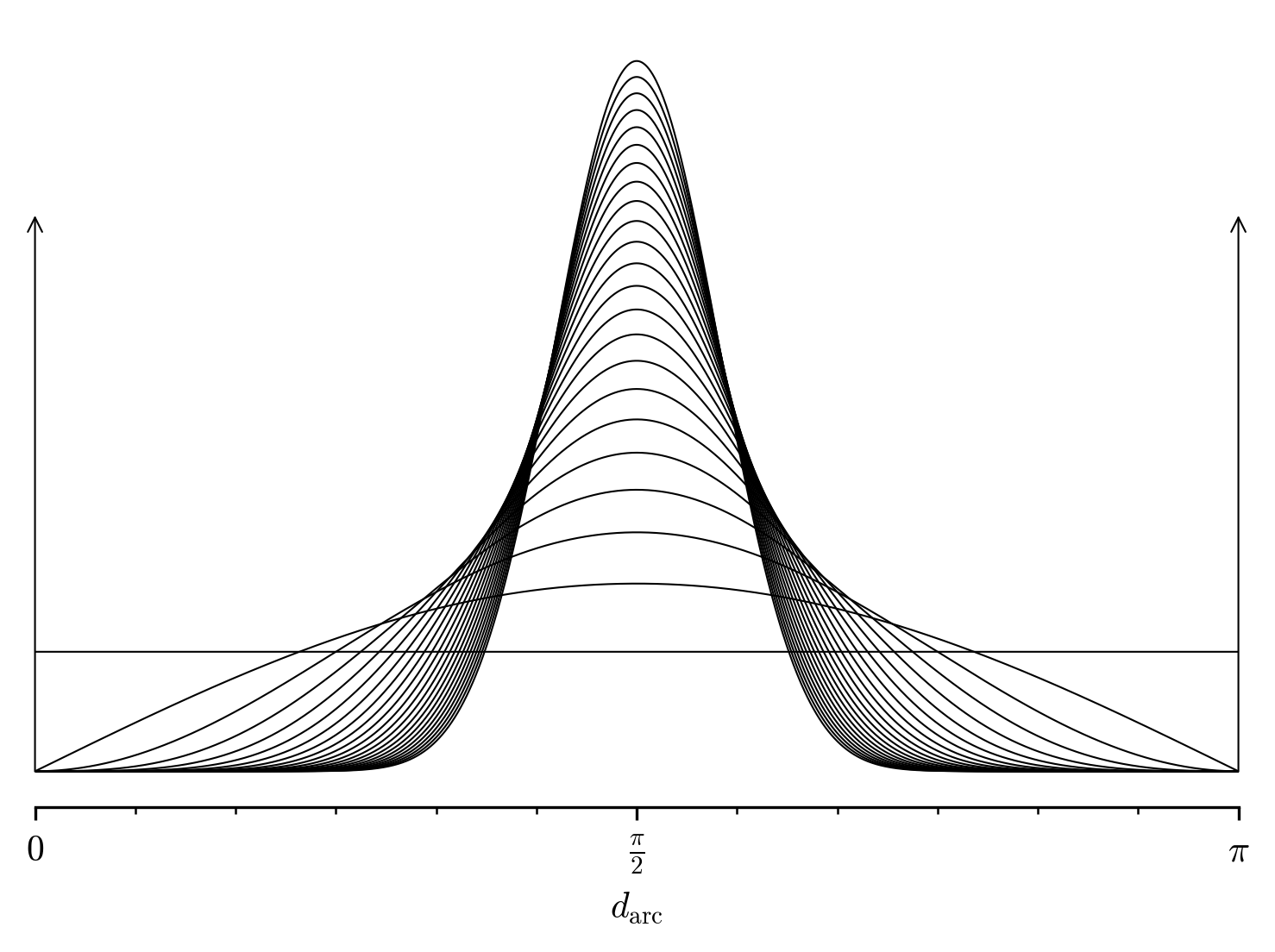$n$-sphere
$$ \gdef\S{\mathrm{S}} \gdef\darc{d_{\mathrm{arc}}} \gdef\a#1#2{\mathrm{A}_{#1}\p{#2}} \gdef\acap#1#2{\mathrm{A}^{\mathrm{\!cap}}_{#1}\p{#2}} $$
Let $\mathrm{S}_n(r)$ be an $n$-dimensional hypersphere, or $n$-sphere, of radius $r$ centered at the origin:
$$ \begin{align} \mathrm{S}_n(r) = \setb{\vec x ∈ \R^n}{\norm{\vec x}_2 = r} \end{align} $$
The volume and surface area of are given by formulas involving the Gamma function $Γ\p{\dummyarg}$:
$$ \begin{align} \mathrm{V}_{n}\p {r} &= \frac{π^{\frac n2}}{\mathrm{Γ}\p{\frac n2 + 1}} r^n &&& \a{n}{r} &= \frac{2 π^{\frac n2}}{\mathrm{Γ}\p{\frac n2}} r^{n-1} \end{align} $$
When the radius is left out it is implied to be one, so $S_n$, $V_n$ and $A_n$ are the unit $n$-sphere and its volume and surface area respectively.
Distance Metrics
There are two commonly used distance functions on the unit $n$-sphere, the chord distance, $d_{\mathrm{chord}}$, and arc length $d_{\mathrm{arc}}$.
The chord length is simply the metric inherited from the surrounding $\R^n$ space
$$ \begin{align} d_{\mathrm{chord}}(\vec a, \vec b) = \norm{\vec a - \vec b}_2 \end{align} $$
The arc length, $\darc$, or great-circle distance, is the length of the shortest path between two points on $\S^n$. In one dimension $\S^1 = \set{-1, 1}$ and $\darc$ is ill-defined because there is no connecting path on $\S^1$. A natural extension in this case is to define $\darc ∈ \set{0, \pi}$. We can compute $\darc$ as
$$ \begin{align} \darc\p{\vec a, \vec b} = \cos^{-1}\p{\vec a ⋅ \vec b} \end{align} $$
While not technically a distance function, another popular function is the 'cosine distance':
$$ \begin{align} d_{\mathrm{cos}}(\vec a, \vec b) = 1 - \vec a ⋅ \vec b \end{align} $$
We can geometrically interpret the various distances by considering the plane spanned by $\vec a$ and $\vec b$ intersecting $\mathrm{S}_n$:

The distances $d_{\mathrm{arc}}$ and $d_{\mathrm{chord}}$ are related by
$$ \begin{align} d_{\mathrm{chord}} &= 2 \sin\p{\frac{d_{\mathrm{arc}}}{2}} &&& d_{\mathrm{arc}} &= 2 \sin^{-1}\p{\frac{d_{\mathrm{chord}}}{2}} \end{align} $$
for small distances they are good approximations of each other with an error of $O(d^3)$.
$\darc$ Distribution
Consider the uniform distribution on the $n$-sphere. Uniform here taken to mean the natural Lebesgue measure. An elegant procedure to sample from this distribution is by generating standard normal random vectors and normalizing them:
def sample_sphere(count=1, n=1, r=1, rng=np.random.default_rng()):
x = rng.standard_normal((count, n))
return r * x / np.linalg.norm(x, axis=1)[:, np.newaxis]
Draw a pair of vectors $\vec a$, $\vec b$ from the unit $n$-sphere and consider their distance $d_{\mathrm{arc}}\p{\vec a, \vec b}$. Let's do this numerically by generating many distances and plotting the histogram. We do this for a number of dimensions to see how the distribution evolves:

We see the exceptional bimodal behaviour in one dimension, in two dimensions the distances are uniformly distributed, and with higher dimensions the distribution converges to $\frac π2$. The value $\frac π2$ is the distance from a pole to the equator. Intuitively as we increase the number of dimensions there will be more space orthogonal to a given vector.
My first guess was a Beta distribution with parameters $α = β = n - 1$. This matches the behaviour at dimensions $1$ and $2$, and behaves similarly for higher dimensions. Unfortunately, for $n=3$ and higher it is very subtly wrong, as can be seen when we overlay it on a high resolution histogram

So let's find the true distribution. Given a point $\vec a ∈ \S^n$, the set of points a distance $d$ away from $\vec a$ is a $n - 1$-sphere of radius $\sin d$, that is $\S^{n-1}\p{\sin d}$. The infinitesimal probability of hitting this set is (see appendix for derivation)
$$ \begin{align} f_n(d) &= \frac{\a{n-1}{\sin θ}}{\a{n}{1}} =\frac{\sin^{n-2} d}{Β\p{\frac 12, \frac n2 - \frac 12}} \end{align} $$
where $Β$ is the Beta function
$$ \begin{align} Β\p{a,b} = \frac{Γ\p{a} Γ\p{b}}{Γ\p{a + b}} \end{align} $$
For consecutive values of $n$ the probability density function $f_n\p{\darc}$ looks like

References
- S. Li (2011). Concise Formulas for the Area and Volume of a Hyperspherical Cap. https://dx.doi.org/10.3923/ajms.2011.66.70
- Panagiotis Sidiropoulos (2014). N-sphere chord length distribution. https://arxiv.org/abs/1411.5639v1
- J.C. Baez, G. Egan, J.D. Cook, D. Piponi (2018). Random Points on a Sphere (Part 1) https://johncarlosbaez.wordpress.com/2018/07/10/random-points-on-a-sphere-part-1/
Appendix: Derivation
$$ \begin{aligned} f_n(d) &= \frac{\a{n-1}{\sin θ}}{\a{n}{1}} = \frac{\p{ \frac{2 π^{\frac{n-1}{2}}}{\mathrm{Γ}\p{\frac {n-1}{2}}} \p{\sin θ}^{n-2} }}{\p{ \frac{2 π^{\frac n2}}{\mathrm{Γ}\p{\frac n2}} 1^{n-1} }} \\&= \frac{1}{\sqrt{π}} \frac{\mathrm{Γ}\p{\frac n2}}{\mathrm{Γ}\p{\frac {n-1}{2}}} \sin^{n-2} θ =\frac{\mathrm{Γ}\p{\frac n2}}{\mathrm{Γ}\p{\frac 12}\mathrm{Γ}\p{\frac n2 - \frac 12}} \sin^{n-2} d \\&= \frac{\sin^{n-2} d}{Β\p{\frac 12, \frac n2 - \frac 12}} \end{aligned} $$
